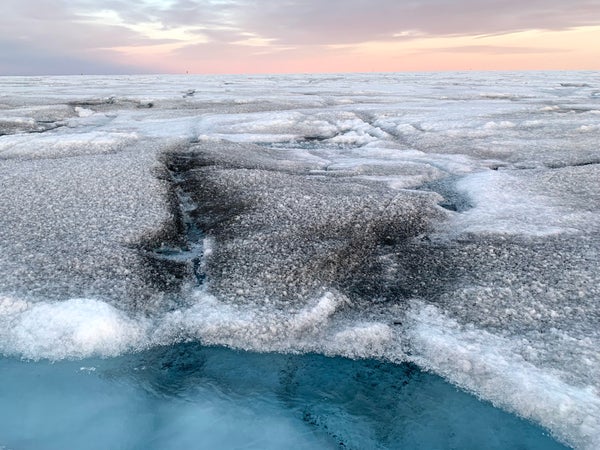Giant virus discovered in Arctic ice could slow sea level rise
Scientists recently discovered a giant virus infecting algal blooms that have spread across the Greenland ice sheet.

Several areas in Greenland are covered in black algae, which can accelerate the melting of ice by absorbing sunlight.
WEATHER | A group of giant viruses live in the world’s second largest glacier – and they may be mitigating the effects of climate change.
Scientists announced the discovery in a recent paper on the Greenland ice sheet. Some of the viruses, they say, have infected algae, inhibiting the growth of colorful snowflakes that could accelerate the melting of ice and raise global sea levels.
“They infect the algae,” said Laura Perini, one of the paper’s lead authors and a researcher at Denmark’s Aarhus University. “If they kill the algae, … then they slow down the rate at which the ice melts.”
On supporting science journalism
If you enjoy this article, consider supporting our award-winning journalism at to register. By purchasing a subscription you help ensure the future of impactful stories about the inventions and ideas that shape our world today.
The Greenland ice sheet is the largest contributor to global sea level rise. Algae can darken the surface of snow, causing it to absorb more sunlight and melt faster.
Researchers suspect that the newly discovered virus is helping to control that algae growth.
That theory remains unproven — and scientists aren’t sure how much the algae contribute to the melting of the Greenland ice sheet. But algal blooms are getting bigger as the planet warms, Perini said, making it important to study the factors that affect their growth.
Since their classification in the 1980s, scientists have discovered giant viruses – or large nucleocytoplasmic DNA viruses – around the world in soil, rivers and oceans. Perini and his team wanted to know if they also live in icy Greenland.
The researchers performed genetic analysis on samples taken from the ice sheet. They found viral genes hiding in algae cells, indicating that the virus had been infecting the algae population for some time – possibly hundreds of years.
The bacteria can kill algae cells and inhibit the growth of blooms, although that was not investigated in the paper, said Frederik Schulz, a biologist at Lawrence Berkeley National Laboratory and one of the world’s leading virus researchers.
“We have some well-studied examples” of seaweed blooms, Schulz said in an interview. “Large viruses play a role there in killing algae.”
If viruses are limiting the number of algae on the Greenland ice sheet, he said, that would mean they are slowing climate-driven global sea-level rise.
“It’s interesting to find cases where large viruses can be important,” said Schulz, who was not involved in Perini’s research. “What if you introduced this virus to, like, the removal of that colorful algae that could slow the melting of the ice?”
Schultz said that might not be a good idea — algae have other functions, like storing carbon — but the research shows it’s worth investigating and put the idea “on my radar.”
Marco Tedesco, a glaciologist at Columbia University who has studied the Greenland ice sheet for years, said the new paper explores important questions about the factors that control algae growth.
“What they did was amazing with DNA,” he said. “This is one of the best studies I’ve seen in years in this field.”
But what that means for Greenland’s future melting rates remains unclear, he added.
That’s because scientists don’t know exactly how much glacier ice melts.
Many studies have confirmed that the black pigments of algae play a role. A 2020 paper found that in some parts of the glacier, between 9 and 13 percent of the meltwater flowing is due to algae.
But there are many other factors that could also affect how the Greenland ice sheet responds to warming, Tedesco added.
When an ice sheet melts, for example, dark pools of water can collect on the surface. These pools can also increase the absorption of sunlight and cause faster melting. It is not known how those processes may interact with algae growth in the coming years.
Perini said other microorganisms can also help control algae. His next paper will look at the parasitic fungi that infect algae.
More data is needed, Tedesco said. And that requires major coordinated research projects, he said, covering many areas of the Greenland ice sheet and involving scientists in many different disciplines, from glaciologists to biologists.
“From a climate perspective, we need support for large-scale scalable testing,” Tedesco said.
Reprinted from E&E news with permission from POLITICO, LLC. Copyright 2024. E&E News provides valuable information for energy and environmental professionals.
#Giant #virus #discovered #Arctic #ice #slow #sea #level #rise